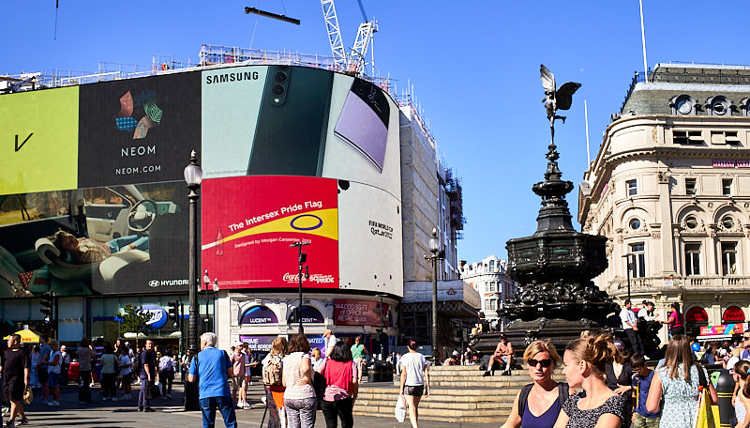Digital signage boosts OOH advertising

Rapidly changing digital screens in high streets and transport networks can reach more customers.
Digital screens have been used for out-of-home (OOH) advertising for over a decade, but in the last few years there has been a huge increase. This has been largely driven by improvements to the screens themselves and an increase in global manufacturing capacity to cope with consumer demands, leading to lower prices.
For many of us, this is just an extension of our personal experiences, given that we are all carrying mobile phones and tablets, and using laptops and large-screen TVs.
The result is that we are all now very used to seeing, and interacting with, screens in all sorts of OOH locations, from airports and hotels to shopping malls and billboards. They are often used for advertising and wayfinding as well as for restaurant menus, train timetables and public service announcements.
There are numerous advantages to using a digital screen. They draw viewers in, mainly because they emit light, unlike a printed display that reflects the light that falls on it. This is enhanced by the use of primary RGB colours rather than CMYK though modern printers and inks are good enough that there is little difference. But unlike print, digital screens can incorporate videos and animation.
However, the biggest benefit is the ability to rapidly change the messages. This could be through a slide deck, rotating through half a dozen different displays over a period of time. It’s also possible to alter the messaging throughout the day. For example, a fast food chain might want to advertise breakfast in the morning, lunch at midday and so on. Or a retailer might want to switch from summer clothes to raincoats and umbrellas to match a sudden change in the weather.
Some businesses might prefer to target a morning crowd, while others aim for people passing by later in the day
Equally, some businesses might prefer to target a morning crowd, while others aim for people passing by later in the day. This gives considerable flexibility to advertisers to make changes during their campaigns. That could involve moving the ads to screens in different locations, extending the campaign or even changing the content to match changing conditions, all at just the click of a button.
Digital signage systems
There are various components to a successful digital sign. Obviously, there is the screen itself, with a good choice of LCD and LED panels available in different sizes. The screen should be bright enough to cope with the ambient conditions of its intended location, particularly for outdoor displays.
There are two basic types of digital screen. Firstly, there are straightforward display boards, ranging in size from small posters to large billboards. Vertical portrait mode posters are becoming quite common on bus shelters and in shopping centres.
Multiple small screens can be particularly effective, such as those alongside escalators at some London Underground stations, where messages can jump from screen to screen to match the pace that the passengers are travelling at.
Screens are also starting to appear on buses and trains, and even built into the headrests of some coaches – flat-screen panels will fit on just about any surface and there are even curved screens now available.
 Digital signage is used on the escalators of the London tube. © Nessan Cleary
Digital signage is used on the escalators of the London tube. © Nessan Cleary
There are some creative variations. Smart Outdoor, for example, has established the Smart D4 national network of over 500 screens located around the UK. The screens are installed in various sites, including shopping malls and the Marston’s chain of pubs, always at eye level. They incorporate a soap dispenser so that people come face to face with the ads when they stop to clean their hands, and when passing by.
Then there are touch screens, which offer a completely different experience. In some cases, these can also include speakers for sound, which is particularly useful for visually impaired people. Another variation on this is to simply use a secure tablet holder and then use a tablet as an interactive touch screen.
However, the main element is the content management system, which drives the media player. In some closed-loop cases the content can be run from a USB stick. But it’s more common to have a fully networked system so that the messages can be updated easily across all the screens from a central location.
The main drawback is the cost of installing and using these screens and for this reason they are mostly found in high footfall areas where the number of potential views can justify this cost.
Print vs digital: sustainability
There is some debate over sustainability. Naturally, those promoting digital signage point out that it’s just changing pixels so there is no waste. However, there is a considerable carbon footprint in manufacturing the screens and their associated network. As with all technology, they have a limited lifespan, typically five to seven years. It is possible to break down these screens for recycling but it’s a complex process. In addition, the screens require a constant power supply, which itself has a considerable carbon footprint.
Printed billboards and other OOH advertising can reach a very wide audience and are relatively inexpensive to produce, install and maintain
It’s difficult to generalise on the sustainability of print, since this largely depends on the substrates and inks used. There’s very little waste involved in a modern print operation. It is true that some displays may have a short lifespan, perhaps just a few weeks, but generally, the shorter the intended lifespan, the more likely that the substrates can be recycled.
Despite their advantages, digital screens are unlikely to replace printed advertising because of the high costs involved. Printed billboards and other OOH advertising can reach a very wide audience and are relatively inexpensive to produce, install and maintain.
You can also spread print billboards around a greater area, significantly amplifying the messaging. In addition, there will always be some locations where print is simply more effective. It’s very easy to include interactivity on printed displays simply by adding a QR code that allows potential customers to gain more information and provides a way for advertisers to determine how effective each individual sign is.
So screens are unlikely to completely replace printed displays but advertisers are increasingly looking towards hybrid campaigns that can use both digital and printed displays to deliver the best return for the optimal cost over a given area.
Become a FESPA member to continue reading
To read more and access exclusive content on the Club FESPA portal, please contact your Local Association. If you are not a current member, please enquire here. If there is no FESPA Association in your country, you can join FESPA Direct. Once you become a FESPA member, you can gain access to the Club FESPA Portal.
Recent news

Steve Lister: a practical guide to making green claims
Sustainability and print consultant Steve Lister describes how printers can avoid accusations of greenwashing.

Does digital marketing really work better than print marketing?
As the popularity of digital marketing continues to rise, is there still a place for print marketing in an increasingly online world? We look at whether digital marketing works better than print, or vice versa.

